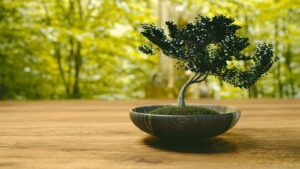 One of the famous Japanese art forms bonsai needs a lot of skill and a combination of horticulture. You can grow your bonsai trees outdoors and it is possible by some extra care. It is not as hard as you think though to perform this art needs a unique technique. Growing bonsai outdoors is possible but needs some extra consideration in mind like selecting species, pruning, and wiring.
One of the famous Japanese art forms bonsai needs a lot of skill and a combination of horticulture. You can grow your bonsai trees outdoors and it is possible by some extra care. It is not as hard as you think though to perform this art needs a unique technique. Growing bonsai outdoors is possible but needs some extra consideration in mind like selecting species, pruning, and wiring.
Here you will learn how to grow bonsai outdoors.
Quick Jump
- Species selection
- Proper light
- Humidity
- Proper watering
- Soil condition
- Fertilizing
- Pruning
- Wiring
- Repotting
Let’s learn the process.
Species selection
Choosing the right species demands information on the hardiness of the species and local climate. Know your area temperature including day and night, the seasonal temperature changes, frost date, and the prevalence of extreme weather events. Choose wisely a minimum winter temperature tolerable species which native to your area. Your local nursery and hardiness zone maps will be best to provide this information.
Keep consideration about micro-climates such as areas near water sources, and wet or humid walls. Which may extend your options of choice.
Deciduous (which lose their leaves in winter) perform better than evergreen in regions with cold winters such as Japanese maple, Chinese elm, Fagus crenata, and so on. Juniper, Pine, Maple, Boxwood, and elm are known for hardiness and adaptability. Don’t forget to keep safe from the harsh winter.
Proper light
Proper sunlight is crucial for outdoor bonsai. They need 4 to 6 hours of direct sunlight per day, especially the morning sun. In winter the tree will need more direct sunlight than in summer, place it in a sunnier spot in winter or bring it into the home to keep safe from frost condition.
Some trees like junipers, pines, and maples can tolerate full sun while other types of species like ficus and azaleas prefer filtered sunlight. Rotate regularly to prevent one side of your bonsai from receiving too much sunlight. Not rotating will change your bonsai shape to one-sided growth. If you see any sign of sunburn such as yellow or green leaves, provide more shade.
Humidity
How much humidity a bonsai needs depends on the mother species’ natural habitat. If you are in a high-humidity region such as a coastal area or near any water source, you don’t need to worry about humidity.
On the other hand, if you live in a dry region you may need to take steps to increase humidity. Placing your bonsai in a humidity tray with water and pebbles can be a good solution to increase humidity. Regular misting can be a good option. Do not overdo it as it can lead to fungal and rotting issues.
Keep your bonsai with other plants because it has a humid microclimate. If you live in an area with very low humidity, you may consider a cold frame or greenhouse.
Proper watering
Check the soil moisture before watering. Stick your finger about an inch into the soil to gauge its moisture. If it feels moist there is no need to water. You can keep a stone on the soil. Lift the soil before watering and if there is moisture under the stone. Wait until the soil gets totally dried out.
Bonsai need water more frequently than normal plants. This frequency depends on the species, local climate, and pot size. Generally every two days in a dry period and less frequently in a cooler and dormant period (in the morning). Water thoroughly until you see any water coming from the pot bottom hole to ensure the entire root system is moistened. Do not allow water to accumulate on the pot and avoid overwatering, as it can cause rot. Use a saucer to prevent excess water from spilling onto the ground.
Soil condition
Bonsai need proper well-draining soil that provides adequate aeration and retains some moisture. Soil mixture needs ingredients like akadama (a type of Japanese clay commonly used in bonsai), pumice (a volcanic rock that helps to improve the drainage system), lava rock (a mineral component that contributes to the aeration system), organic matter (like bark or sphagnum moss), perlite (volcanic lightweight rock), and sand for more aeration.
The exact mixture ratio depends on the species. The average ratio is akadama, pumice, and lava rock 1:1:1. Buying bonsai soil is preferable.
Fertilizing
Proper fertilizing is necessary for a bonsai as it doesn’t get any from nature. You can use solid bonsai fertilizer. It is typically a slow release. Bonsai fertilizer also includes liquid fertilizer used by mixing with water.
Start fertilizing in spring when they start to show new growth (March to April) depending on your climate. Continue fertilizing in summer frequently every 15 to 30 days. Reduce or stop fertilizing in winter months when they are in a dormant period. Apply fertilizer to the soil and avoid touching the tree.
Pruning
Pruning is a major skill for bonsai cultivation. Clean and sharp tools specialized for pruning. There’s no specific requirement for shaping. Shape as you want but keep in mind balancing and harmoniousness. Pruning should be a balanced distribution of foliage, branches, and leaves. The lower branches should be larger and longer than the upper branches to create a sense of scale.
Regularly remove dead, diseased, or pest-infected branches. Prune gradually and avoid pruning too much at a time it may cause death. Don’t prune without thinking because it is a commitment of long-term. So don’t rush if you don’t want to regret it.
Wiring
Bonsai wiring is essential to shape in your own way. Use thicker or thinner wire specialized for bonsai for larger and smaller branches. Wire in the dormant period, winter or early spring for deciduous and year-round for evergreen species. Have a clear vision of which shape you want to create, understanding the growing pattern. Do not over-bend and try to force it into an unnatural shape. Do not keep wire for too long it may end up scarring your bonsai.
Repotting
Repot every 2-3 years depending on the overall growth. Detach the soil from the root with a steel rake. Prune some crowded roots while doing that. Now change the soil.
